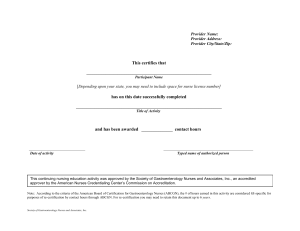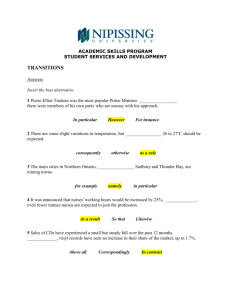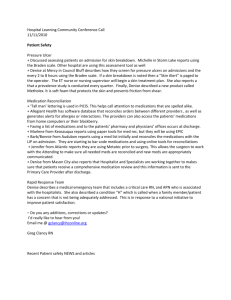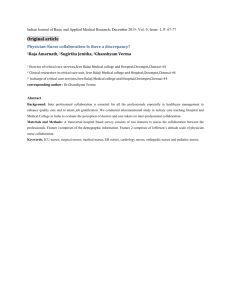Part 2 Survey Data - Arkansas Coordinated School Health
advertisement
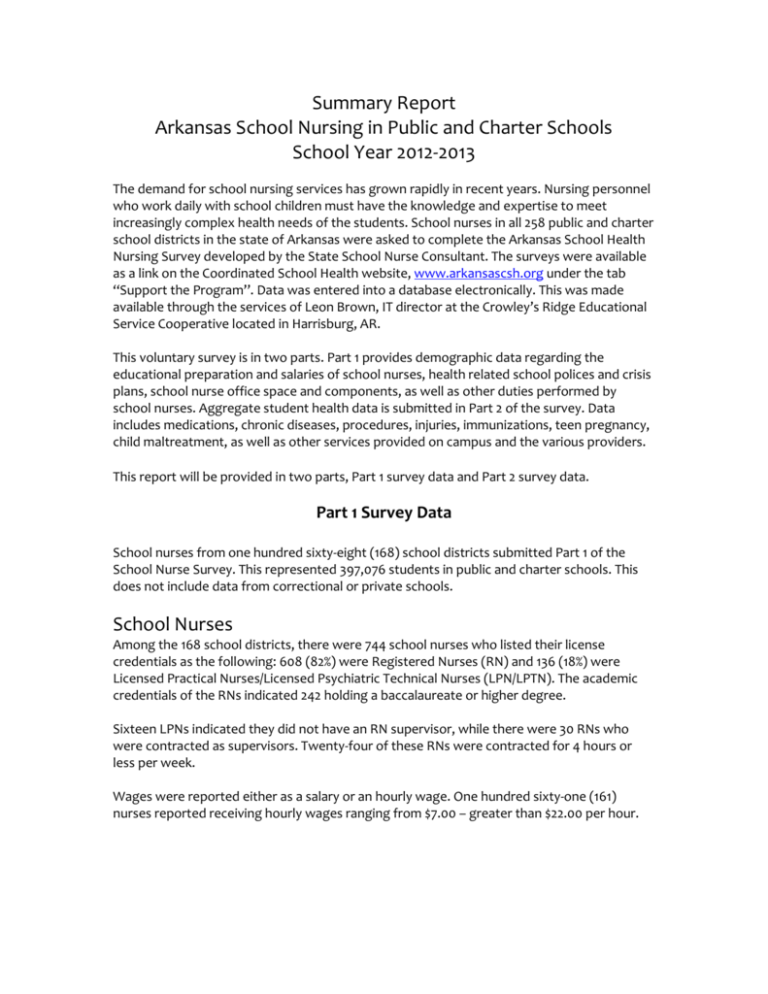
Summary Report Arkansas School Nursing in Public and Charter Schools School Year 2012-2013 The demand for school nursing services has grown rapidly in recent years. Nursing personnel who work daily with school children must have the knowledge and expertise to meet increasingly complex health needs of the students. School nurses in all 258 public and charter school districts in the state of Arkansas were asked to complete the Arkansas School Health Nursing Survey developed by the State School Nurse Consultant. The surveys were available as a link on the Coordinated School Health website, www.arkansascsh.org under the tab “Support the Program”. Data was entered into a database electronically. This was made available through the services of Leon Brown, IT director at the Crowley’s Ridge Educational Service Cooperative located in Harrisburg, AR. This voluntary survey is in two parts. Part 1 provides demographic data regarding the educational preparation and salaries of school nurses, health related school polices and crisis plans, school nurse office space and components, as well as other duties performed by school nurses. Aggregate student health data is submitted in Part 2 of the survey. Data includes medications, chronic diseases, procedures, injuries, immunizations, teen pregnancy, child maltreatment, as well as other services provided on campus and the various providers. This report will be provided in two parts, Part 1 survey data and Part 2 survey data. Part 1 Survey Data School nurses from one hundred sixty-eight (168) school districts submitted Part 1 of the School Nurse Survey. This represented 397,076 students in public and charter schools. This does not include data from correctional or private schools. School Nurses Among the 168 school districts, there were 744 school nurses who listed their license credentials as the following: 608 (82%) were Registered Nurses (RN) and 136 (18%) were Licensed Practical Nurses/Licensed Psychiatric Technical Nurses (LPN/LPTN). The academic credentials of the RNs indicated 242 holding a baccalaureate or higher degree. Sixteen LPNs indicated they did not have an RN supervisor, while there were 30 RNs who were contracted as supervisors. Twenty-four of these RNs were contracted for 4 hours or less per week. Wages were reported either as a salary or an hourly wage. One hundred sixty-one (161) nurses reported receiving hourly wages ranging from $7.00 – greater than $22.00 per hour. Number reporting 1 13 31 30 22 64 Hourly Wage range $7.00 – 9.99 $10.00 – 12.99 $13.00 – 15.99 $16.00 – 18.99 $19.00 – 21.99 Greater than $22.00 Nurses reporting they were paid a salary indicated the following. Number reporting 12 33 96 78 105 109 109 58 16 26 1 Salary Range Less than $15,000 $15,000 – 19,999 $20,000 – 24,999 $25,000 – 29,999 $30,000 – 34,999 $35,000 – 39,999 $40,000 – 44,999 $45,000 – 49,999 $50,000 – 54,999 $55,000 – 59,999 Greater than $60,000 School Policies Policies are essential to guide the development and implementation of school programs. School nurses reported the presence of written, school board approved policies that could be found in the student handbook and/or the personnel policy handbook. Six hundred seventy nine (679) school nurses reported having a policy for medication administration while 629 nurses had a policy for Communicable Disease management. Six hundred twenty-eight nurses had policies for reporting an injury, while 550 nurses had a policy requiring staff trained in Cardio-Pulmonary Resuscitation (CPR) and 523 nurses had policies requiring staff trained in First Aid. Written, school board approved health policies: School Year 2012-2013 Policy Medication Administration Communicable Disease Management Reporting Injuries Staff trained in CPR Staff trained in First Aid Nurses reporting 679 629 628 550 523 The School Nurse’s Office Six hundred sixty-one school nurses reported if they had a designated space or office and those items contained in their office. Office Have Do Not Have Designated space Heat Air-conditioning Computer Internet access Privacy Telephone Toilet facilities Shower Cot Double-locked cabinet Secure file cabinet Refrigerator (Medication storage) Sharps container Sink with water Hot water 649 646 647 636 642 599 639 540 292 647 441 603 578 12 15 14 25 19 62 22 121 369 14 220 58 83 631 596 528 30 65 133 School Committees and Other Responsibilities Four hundred eighty school nurses reported being a part of several committees in the school district. Some of these committees include: student handbook (8.8%), emergency preparedness (48.1%), child nutrition/physical activity (15.1%), 504 (41.9%), hometown health improvement (6.5%), crisis team (55.4%) and other (16.3%) to include literacy. Two hundred forty-five school nurses reported they are also required to fulfill other needs at school. These other needs include: bus duty (9.4%), lunch duty (10.6%), morning duty (7.4%), classroom substitute (5.7%), drug testing coordinator ( 25.3%), Workman’s Compensation (34.3%), emergency preparedness (38%), school secretary substitute (52.2%), attendance clerk (3.7%), Benchmark Testing Monitor (6.1%) and other (42%) including wellness committee chair, testing proctor, car duty, translator, and substitute office secretary. Part 2 Survey Data One hundred forty-nine school districts representing 229,742 students were reported by 413 school nurses on Part 2 of the Arkansas School Nurse Survey. The results are as follows. Chronic Illness/Disabilities Changes in American society, nursing practice and the nature of youth health services have resulted in an increased demand for expert clinical health services in youth oriented settings, such as schools. Advances in health care and technology have increased the survival rate and life expectancy of low birth weight infants, children with chronic illnesses, congenital anomalies and those who have survived traumatic injuries. Some of these children have special healthcare needs, such as technology assistance, medication and treatment administration, and supplemental nutrition that must be addressed while the child is away from home. An even greater number of children have long-term chronic medical conditions such as diabetes, asthma, anemia, hemophilia, seizures, and childhood cancers just to name a few. Some of these conditions require daily management in a setting outside of the home, while other conditions may require only intermittent management or acute care procedures on an emergency basis. These changes have also heightened the need for population based health promotion, prevention, and early intervention services. Safe and accountable nursing practice requires adherence to the nursing process (assessment, diagnosis, outcome identification, planning, implementation, and evaluation) and systematic, continuous documentation of the individual care provided to clients (AR State Board of Nursing School Nurse Roles and Responsibilities Practice Guidelines). As a result, an increasing number of students with chronic health conditions attend school. These conditions can affect attendance, school performance, and the student’s level of wellbeing. School nurses work closely with students, their families and health care providers as well as school administrators and staff to reduce the negative impact of illness on learning. Some of the responsibilities nurses have in caring for students with chronic illnesses or disabilities are to serve as case managers, evaluate activities of daily living, and assist with the development of appropriate modifications for the learning environment. In the 2012-2013 school year, 48,851 students in the school districts reported having a chronic illness and/or a disability. This represents 21% of the student population of the elementary, middle and high school campuses in these districts. Six percent (6%) of these students reported having asthma, a major chronic illness among school-age children. The numbers and rankings of the ten most reported conditions in these 149 districts can be found in the table below. Chronic Health Conditions: School Year 2012-2013 Type of Condition (Rank) ADD/ADHD (1) Allergies (Life-threatening) (3) Anorexia/Bulimia Asthma (2) Autism (6) Blind/Visually impaired (7) Cardiovascular Cerebral Palsy Cytomegalovirus Cystic Fibrosis Deaf/Hearing Impaired (10) Depression (5) Diabetes, Type I Down’s Syndrome Genetic Diseases, other Hemophilia/Bleeding disorder Hepatitis B/C HIV/AIDS Hypertension Malignant Disease Migraine Headaches, with Rx (9) Neuromuscular Disease Muscular Dystrophy Multiple Sclerosis Orthopedic disability (permanent) Psychiatric Disorder (4) Renal Disease Rheumatoid Arthritis Seizure Disorder (8) Sickle Cell Anemia Spina Bifida Substance Abuse (known) Ulcers TOTAL Number of Students with Known Condition TOTAL 17,016 3,102 115 13,669 1,772 1,701 726 455 12 54 823 1,808 534 214 443 108 10 8 415 66 1,175 101 34 16 230 2,041 127 100 1,290 168 85 307 176 48,851 Health Care Procedures at School Some students with chronic illnesses and/or disabilities require health care procedures to be performed during the school day. School nurses from the reporting districts revealed 4,740 students needing specialized care. The following table illustrates the diversity of some of the more commonly performed procedures performed at school. Children requiring specialized care at school: School Year 2012-2013 Procedure Number of students Bladder Program 316 Blood Glucose testing 631 Bowel Program 293 Catheterization by Nurse or Aide 34 Catheterization by Self 46 Dialysis (Peritoneal) 5 Diapering/Personal Toileting 674 Feeding Assistance (oral) 365 Nebulizer 337 Range of Motion Exercises 343 Respiratory Care (i.e. oxygen, postural drainage) 35 Stoma Care 72 Suctioning 29 Tracheostomy Care 16 Tube Feedings 156 Ventilator Assisted Care 1 Sub-cutaneous medications 339 Intramuscular Medications 76 Intravenous Medications 3 Other Procedures 97 TOTAL 4,740 Pregnancy In the school year 2012-2013, there were 528 known student pregnancies. Of these, 76 received homebound services as a result of complications such as pre-eclampsia and pre-term labor. Fifty-four students quit attending school altogether. Forty-two students were diagnosed as high risk requiring frequent monitoring of blood pressure, contractions and other symptoms indicating an increase in blood pressure. Students known to be pregnant: School Year 2012-2013 TOTAL Total number of known pregnancies 528 Number receiving homebound services 76 Number who dropped out of school 54 Number diagnosed as high risk 42 Abuse/Neglect In an effort to protect all students, Arkansas Law states “It is the public policy of the State of Arkansas to protect the health, safety, and the welfare of minors within the state.” In addition, among the list of mandated reporters of suspected abuse or neglect are “a licensed nurse, mental health professional, school counselor, school official, social worker, and teacher” (Act 1236 of 2011). In the 2012-2013 school year, school nurses from the 148 school districts indicated there were 1188 reported cases of child abuse, 257 cases of sexual abuse, 868 reported cases of neglect and 445 other cases of abuse for a total of 2,758 cases of abuse. Reported Cases of Abuse: School Year 2008-2009 TOTAL Reported cases of child abuse 1188 Reported cases of sexual abuse 257 Reported cases of neglect 868 Reported cases of other abuses 445 TOTAL CASES OF REPORTED 2,758 ABUSE Medication Administration During the 2012-2013 school year, school nurses reported that 48,931 students received medication while at school. Of these, 6,191 students received prescribed medications on a long-term basis, that is, longer than three weeks. Another 7,912 students received prescribed medications on a short-term basis, less than three weeks. Eleven thousand five hundred sixty-four students were given medications on a PRN (as-needed) basis. These PRN medications were prescribed by the student’s health care provider (HCP) and sometimes include Over the counter (OTC) medications include but are not limited to acetaminophen, ibuprofen and benadryl. The largest number of students receiving PRN medications (23,264) are OTC medications without a health care provider’s order. Number of students receiving medications at school: School Year 2012-2013 Students on long-term medicine ( >3 weeks) Students on short-term medicine (<3 weeks) Students on PRN medicines with a HCP’s order Students receiving PRN meds without a HCP’s order TOTAL TOTAL 6,191 7,912 11,564 23,264 48,931 Rescue medications include rescue asthma inhalers, glucagon, rectal Diastat (valium), Versed (midazolam), Ativan (lorazepam) and epinephrine auto-injectors. Rescue Medication # Students with a prescription for medication # Students receiving medication # Doses administered by a licensed nurse 55 10 8175 # Students with condition specific emergency action plan 2076 446 7121 Epinephrine Glucagon Fast acting beta agonist (Albuterol) Rectal Valium Nasal Midazolam Buccal Lorazepam 2137 457 8640 # Times 911 was called during episode 27 20 59,507 # Doses administered by an Unlicensed Assistive Personnel (UAP) 1 0 5328 334 26 41 16 321 27 46 93 0 4 17 2 8 11 7 17 1 0 17 1 30 Injuries/Emergency Care Injuries are common occurrences in the school-aged population. Many minor incidents occur to students and staff during the course of the school day. School nurses reported 397,125 at-school minor injuries requiring first-aid and 21,244 major injuries requiring EMS or immediate care by a physician or dentist and loss of at least ½ school day. Injuries requiring EMS or immediate care by a MD or dentist AND loss of at least ½ school day(s) Type of injury (give # in each category) Bus Hall Classroom Playground Athletics PE Class Agri Shop Restroom Lunchroom Other Total Respiratory emergencies Head Injury Back Injury Eye Injury Fracture Sprain or Strain Laceration Dental Injury Anaphylaxis Psychiatric Emergencies Heat Related Emergencies Other TOTALS 41 123 285 568 297 196 0 10 19 68 1607 22 208 16 21 25 23 4 0 14 125 37 113 66 103 153 13 1 84 278 28 277 56 122 334 88 29 298 1164 133 352 642 2124 2652 282 14 92 439 123 105 284 1712 421 58 0 12 223 39 83 182 552 232 62 0 3 4 1 33 5 6 90 0 0 0 18 10 11 2 9 11 1 0 6 8 4 7 5 7 18 7 6 12 95 20 53 170 260 331 84 8 72 2376 603 1050 1433 4920 4265 599 58 593 3 17 89 58 43 55 2 0 0 10 277 43 420 1048 1883 1159 3043 1094 9175 21 3515 6 1633 0 141 0 78 11 104 81 1252 3463 21,244 There were adverse outcomes for some of the students with serious injuries occurring at school. Sixty-four serious injuries resulted in a permanent disability. Two hundred thirty-six injuries occurred as a result from an incident requiring law enforcement intervention. Other Services It is important to note that the 413 school nurses also reported the number of vaccines provided at their school through the collaboration between their district and local health unit(s). Three hundred seventy-six nurses reported holding the immunization clinic during school hours, another 24 nurses held the clinic after school hours and 39 reported they did not hold an immunization clinic. Presently, there are 21 school based health centers in Arkansas. With this opportunity, several districts reported other health care professionals providing services for their students. These professionals included physicians, advanced practice nurses (APNs), physician’s assistants (PA), Audiologist, eye doctor, registered dietician, mental health professional, certified diabetes educator, dentist, and dental hygienist. School nurses also are involved in health care coordination. These activities include parent/guardian conferences, 504/Individual Education plan (IEP) conferences with special education personnel, home visits, consultations with health care providers, meetings with support staff, and community partners. Special Considerations It is important to note that in the 148 reporting school districts there were 5 students with a Do Not Resuscitate (DNR) order. Of these five, 3 nurses reported their administrator was in agreement with the DNR orders for the students, one administrator was not and one did not indicate agreement or disagreement.


